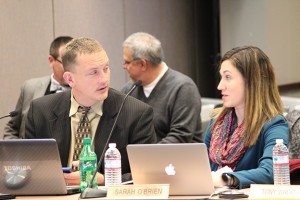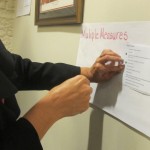Tame State Board Meeting Is Newsworthy In And Of Itself
After months of strained relations capped by proposals for some dramatic changes to aid group dynamics, the first State Board of Education meeting of the new year was…well, calm.

State Board of Education members Brad Oliver (left), state superintendent Glenda Ritz, and Dr. David Freitas listen to presentations at the January board meeting. (Photo Credit: Rachel Morello/StateImpact Indiana)
The group met Wednesday to go over an agenda packed with discussions of school grades, school turnarounds, along with other big-ticket items – and for the first time in what seems like forever, board members tended to interact cordially with one another.
Particularly in the last few months of 2014, state superintendent Glenda Ritz got tangled in less-than-friendly exchanges with various board members, more often than not regarding issues of board procedure and authority. It all culminated in a decision by Governor Mike Pence to disband his education agency, the Center for Education and Career Innovation, which Ritz has frequently called a “shadow” of her own Department of Education.
Wednesday’s meeting was the second-to-last at which CECI staff members would participate. The group officially dissolves February 20.
Aside from a small moment between CECI and IDOE staffers, who argued about when certain materials had been released to board members, everyone seemed to work together cohesively to make moves on several policy items. Here’s the rundown:
New A-F accountability rules. The board approved final recommendations from the A-F panel. This sets a public hearing process in motion. The board is required to hold three hearings for public comment on the proposed changes, which they would ideally like to complete soon so schools can look at the new language before school starts next August. Board member Andrea Neal told her colleagues she was wary of moving forward on the rules because they are based on a high-stakes assessment that has not been completed – which brings us to…
State assessments. The board has yet to select a vendor to create the 2016 version of the new ISTEP+ test. Ritz told board members the IDOE is working on the request for proposal.
Teacher evaluations. According to data from the Indiana Department of Education, less than 0.5 percent of educators received “ineffective” ratings during the 2013-14 school year – about the same percentage as last year. Close to 89 percent of teachers, principals and superintendents ranked in the top two categories – “effective” and “highly effective.” Ritz told press she thinks those numbers are valid, despite how positive they seem.

Board members B.J. Watts (left) and Sarah O’Brien chat. Both are teachers in public elementary schools. (Photo Credit: Rachel Morello/StateImpact Indiana)
Several board members questioned the toughness of the newer evaluation system, particularly the data point that about 5 percent of teachers in F-rated Indiana schools rated as “ineffective” or “needs improvement.”
“I absolutely believe we have a large percentage of highly effective teachers, but part of us has to say, ‘Is the system doing what it was intended to do, which is provide an honest reflection?'” asks board member Brad Oliver. “We need to understand the total picture.”
The discussion even engaged some of the board’s quieter members.
“I think we’re confusing school grades with teacher effectiveness,” B.J. Watts cautioned the board. “It’s possible to have highly effective teachers in low-rated schools.”
“What other profession relies on results of six- to 19-year-olds?” board member Troy Albert added. “We have no control of who we get. We take who lives in our districts, we work with them, we do all the standards, we do all the assessments, and you know what, we have no control.”
“Virtual option” for snow days. Last month, the board debated whether schools should be allowed to hold “eLearning Days” in place of traditional snow make-up days, ultimately deciding to seek legislative guidance on the option. The board is still waiting to hear back from the General Assembly, which began the 2015 legislative session Tuesday.

